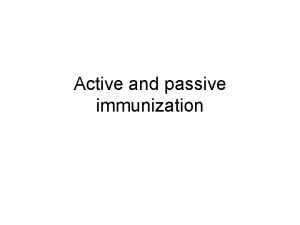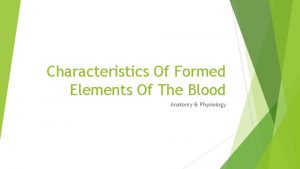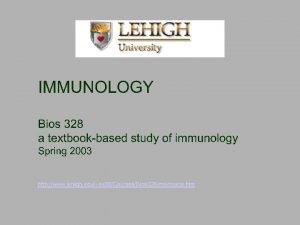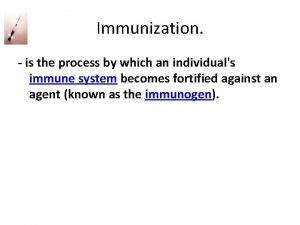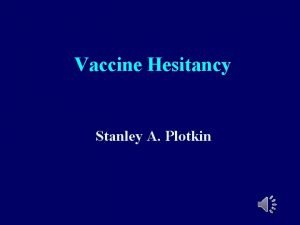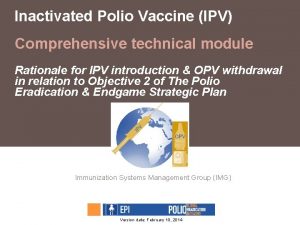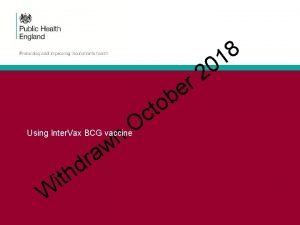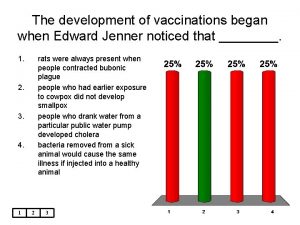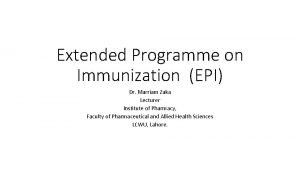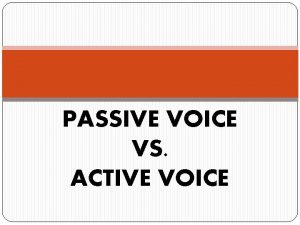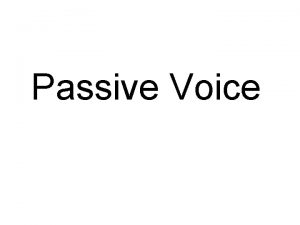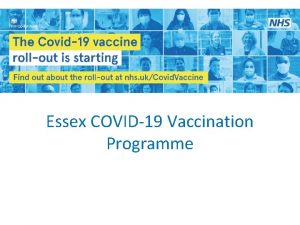ACTIVE PASSIVE IMMUNIZATION VACCINATION Immunization Natural Infection active












- Slides: 12

ACTIVE & PASSIVE IMMUNIZATION (VACCINATION)

Immunization Natural: Infection = active Antibodies from mother = passive (transplacentary only Ig. G, half a year protection) Artificial: Vaccination - active Antibodies dosage (immunoglobulins) passive

History Edward Jenner investigated, that dairy maid infected with cowpox were resistant also against smallpox. 14. 5. 1796 first aplication of “vaccine”. 1885 - Louis Pasteur used attenuated rabies virus as vaccination Nobel prize 1901 - von Behring – antitoxic serum against diphteria 1. 1. 1980 WHO proclaimed eradication of smallpox.

Vaccination 1. Toxoids 2. Inactivated vaccines 3. Chemovaccines 4. Recombinant vaccines 5. Attenuated live vaccines

Toxoids Modified form of the toxin that preserves its antigenicity but has lost its toxicity. We use adjuvants. 1. Tetanus (Clostridium tetani ) 2. Diphteria (Corynebacterium diphteriae) 3. Staphylococci

Inactivated vaccines Bacterins = carefully killed bacterial suspension Against viruses = influenza, poliomyelitis, rabies, tick born encephalitis Autovaccines = microbial strain originate from ill (vaginal candidosis – C. albicans, S. aureus, E. coli, H. influenzae…)

Chemovaccines andantigens recombinant vaccines Isolated protected Bacterial: against Haemophilus influenzae type b, N. meningitidis A + C, S. pneumoniae (23 frequent serotypes) Viruses: influenza A, hepatitis A, tick born encephalitis Recombinant vaccines = „made in“ E. coli (hepatitis B)

Attenuated live vaccines Reproduction in area of giving – mild infection – high effectivity, longlasting, also stimulating cellular immunity Attenuation – pasaging on artificial media or on tissue cultures (viruses) – reducing of the virulence 1. BCG (bacille Calmette-Guérin) – M. tuberculosis 2. Live virus polio (Sabin) - p. o. 3. Mumps, measles, rubella 4. Yellow fever

Vaccinacion types 1. Regular – this calendary depends on country 2. Special – for person in risk (hepatitis A, rabies, influenza, meningococcus) 3. Extraordinary – in epidemia/extraordinary situation 4. In accidents – tetanus, rabies 5. Protecting the traveller – yellow fever, hepatitis A and B, Japanes B encephalitis, tetanus, poliomyelitis, abdominal tyfus, cholera 6. For request – influenza, tick born encephalitis, meningococcus (against meningitis)

Contra- indications Acute illnes Patients in reconvalescence Immuncompromised patients !!!! Patient with alergy, pregnant women – attention!!!

Artificial passive immunization Heterologous (animal) immunoglobulines: antigangrenous (low effectivity), against botulism, staphylococci infections, viperic poison, rabies alergic reactions Homologous (human) immunoglobulines: various antibody defects, profylaxis of hepatitis A, against sepsis, hard absceding infections and difficult virosis (Ebola)

New trends Edible vaccines – tomato/banana producing antigens of diarrhea agens DNA vaccines – injected into muscle or skin, produce protective antigens and cytokins Intradermal or mucous aplication – contact with dendritic cells Ideal vaccine: Cheap, stable, safe, lifelong protection, effective immunity
 Epitop
Epitop Active phagocytes that increase rapidly acute infection
Active phagocytes that increase rapidly acute infection The major disadvantage of passive immunization is that it
The major disadvantage of passive immunization is that it Active immunization definition
Active immunization definition Niccolo paganini fingers
Niccolo paganini fingers Mandatory vaccination
Mandatory vaccination Vaccination dose
Vaccination dose Dog spay perry county
Dog spay perry county Lokstallarna jönköping vaccination
Lokstallarna jönköping vaccination Intervax bcg
Intervax bcg Directions for producing mhcs come from
Directions for producing mhcs come from Epi schedule pakistan
Epi schedule pakistan 10 rights of medication administration
10 rights of medication administration
